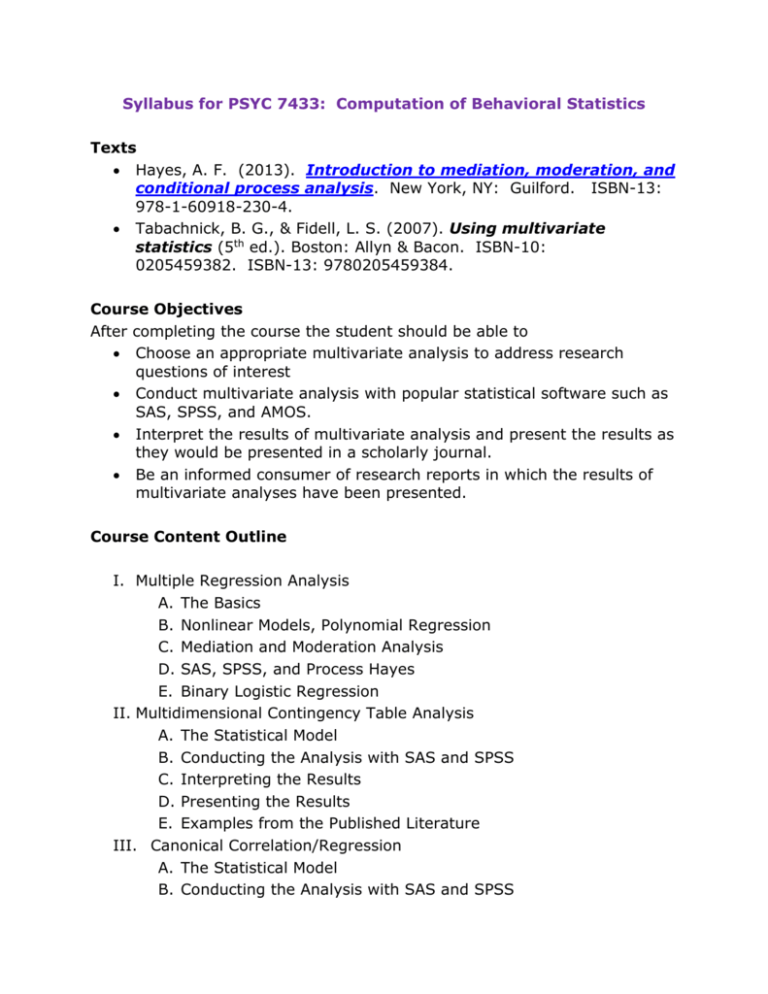Syllabus for PSYC 7433: Multivariate Statistical Analysis
advertisement

Syllabus for PSYC 7433: Computation of Behavioral Statistics Texts Hayes, A. F. (2013). Introduction to mediation, moderation, and conditional process analysis. New York, NY: Guilford. ISBN-13: 978-1-60918-230-4. Tabachnick, B. G., & Fidell, L. S. (2007). Using multivariate statistics (5th ed.). Boston: Allyn & Bacon. ISBN-10: 0205459382. ISBN-13: 9780205459384. Course Objectives After completing the course the student should be able to Choose an appropriate multivariate analysis to address research questions of interest Conduct multivariate analysis with popular statistical software such as SAS, SPSS, and AMOS. Interpret the results of multivariate analysis and present the results as they would be presented in a scholarly journal. Be an informed consumer of research reports in which the results of multivariate analyses have been presented. Course Content Outline I. Multiple Regression Analysis A. The Basics B. Nonlinear Models, Polynomial Regression C. Mediation and Moderation Analysis D. SAS, SPSS, and Process Hayes E. Binary Logistic Regression II. Multidimensional Contingency Table Analysis A. The Statistical Model B. Conducting the Analysis with SAS and SPSS C. Interpreting the Results D. Presenting the Results E. Examples from the Published Literature III. Canonical Correlation/Regression A. The Statistical Model B. Conducting the Analysis with SAS and SPSS C. Interpreting the Results D. Presenting the Results E. Examples from the Published Literature IV. Least Squares ANOVA and ANCOV A. The Statistical Model and Dummy Variable Coding B. Conducting the Analysis with SAS and SPSS C. Interpreting the Results D. Presenting the Results E. Examples from the Published Literature V. Correlated Samples ANOVA A. The Statistical Model: Univariate-Approach and MultivariateApproach B. Conducting the Analysis with SAS and SPSS C. Interpreting the Results D. Presenting the Results E. Examples from the Published Literature VI. Discriminant Function Analysis A. Brief Introduction to Bayesian Statistics B. The Statistical Model C. Conducting the Analysis with SAS and SPSS D. Interpreting the Results E. Presenting the Results F. Examples from the Published Literature VII. MANOVA A. The Statistical Model B. Conducting the Analysis with SAS and SPSS C. Interpreting the Results D. Presenting the Results E. Examples from the Published Literature VIII. Principal Components and Factor Analysis A. The Statistical Model B. Conducting the Analysis with SAS and SPSS C. Interpreting the Results D. Presenting the Results E. Examples from the Published Literature IX.Path Analysis A. The Statistical Model B. Conducting the Analysis with SAS and SPSS C. Interpreting the Results D. Presenting the Results E. Examples from the Published Literature X. Structural Equation Modeling A. The Statistical Model B. Conducting the Analysis with SAS and AMOS C. Interpreting the Results D. Presenting the Results E. Examples from the Published Literature XI.Cluster Analysis A. The Statistical Model B. Conducting the Analysis with SPSS C. Interpreting the Results D. Presenting the Results E. Examples from the Published Literature XII. Hierarchical Linear Modeling A. The Statistical Model B. Conducting the Analysis with SAS and SPSS C. Interpreting the Results D. Presenting the Results E. Examples from the Published Literature Students will conduct analyses on data provided by the instructor and will present the results of those analyses in written and oral research reports. Students will complete quizzes and examinations. Return to the PSYC 7433 Base Page









